WSIS+10
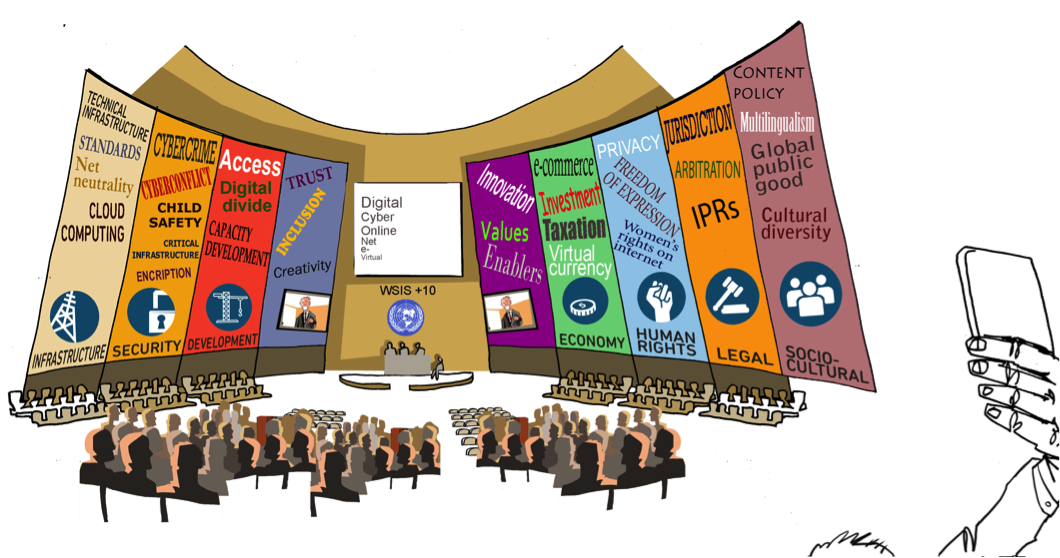
This reporting project was made possible thanks to the support of DiploFoundation, ICANN, and the Internet Society. View or download our resources on the WSIS+10 process and high-level meeting, as well as other important resources:
- The WSIS+10 Summary Report
- Adopted outcome document of the high-level meeting of the General Assembly on the overall review of the implementation of the outcomes of the World Summit on the Information Society
- WSIS+10 Daily No. 2
- WSIS+10 Daily No. 1
- Just-in-time reporting from WSIS+10 General Assembly High-Level Meeting
- Overview of instruments referred to in the WSIS+10 outcome document
- Timeline of the WSIS+10 Review Process (Jun – Dec 2015)
Timetable, info and reports
Monday, 14th December
|
Time |
Events |
Organiser |
|
13:15 – 14:30 |
Dot Africa gTLD: The Hope for Realising Africa’s Digital Presence | Info | Report |
ZACR Dot Africa, Mission of African Union |
|
13:15 – 14:30 |
Strengthening the Impact of WSIS Action Lines for Sustainable Development: Showcasing Best Practices, Transferring Know-how, Fostering Partnerships | Info | Broadcasting | Report |
ITU |
|
13:15 – 14:30 |
IGF: Internet Governance Empowering Sustainable Development | Report |
Mission of Brazil and Internet Governance Forum Organizers |
|
13:15 – 14:30 |
ICT for All Outcomes | Info |
Mission of Tunisia |
|
18:00 – 20:00 |
UN Women, ITU |
Tuesday, 15th December
|
Time |
Events |
Organiser |
|
9:00 – 10:00 |
United Arab Emirates, Latvia | |
|
13:15 – 14:30 |
Building on WSIS+10: Putting Knowledge Societies at the Heart of the 2030 Agenda | Info | Report |
UNESCO |
|
13:15 – 14:30 |
Women’s Empowerment in the Digital Age: Implementing WSIS Outcome and Agenda 2030 | Info | Report |
Costa Rica, Sweden, Switzerland, Tunisia, ITU, UN Women, Microsoft |
|
13:15 – 14:30 |
ICC-BASIS, AfICTA, African Union | |
|
15:00 – 16:30 |
Netherlands, Senegal | |
|
15:00 – 16:45 |
Measuring the Information Society: Progress to Date and Challenges Ahead | Info |
Partnership on Measuring ICT for Development |
Wednesday, 16th December
|
Time |
Events |
Organiser |
|
11:00 – 12:30 |
Presentation of GIP Digital Watch: A Practical Tool for Navigating the Complex Field of Digital Policy | Info | Report |
DiploFoundation, Geneva Internet Platform, Internet Society |
|
13:15 – 14:30 |
ITU | |
|
13:15 – 14:30 |
Towards 2030: Sustainable Development in a Digital World | Info |
Mission of Ireland and Global Pulse |
|
13:15 – 14:30 |
Collaboration for Access and Connectivity in Developing Countries: The Best Routes of the Past and the Best Practices for the Future | Info | Report |
The Internet Society |
WSIS+10 Daily
|
Daily no. 1 was available on Tuesday, |
Daily no. 2 was available on Wednesday, |
Summary Report was available on Friday, |
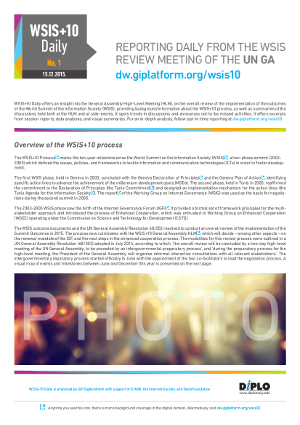 |
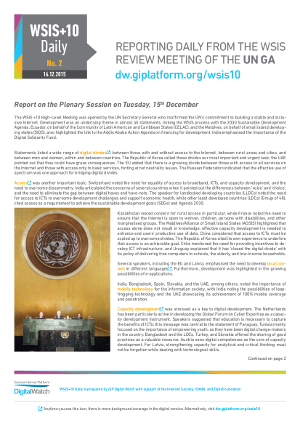 |
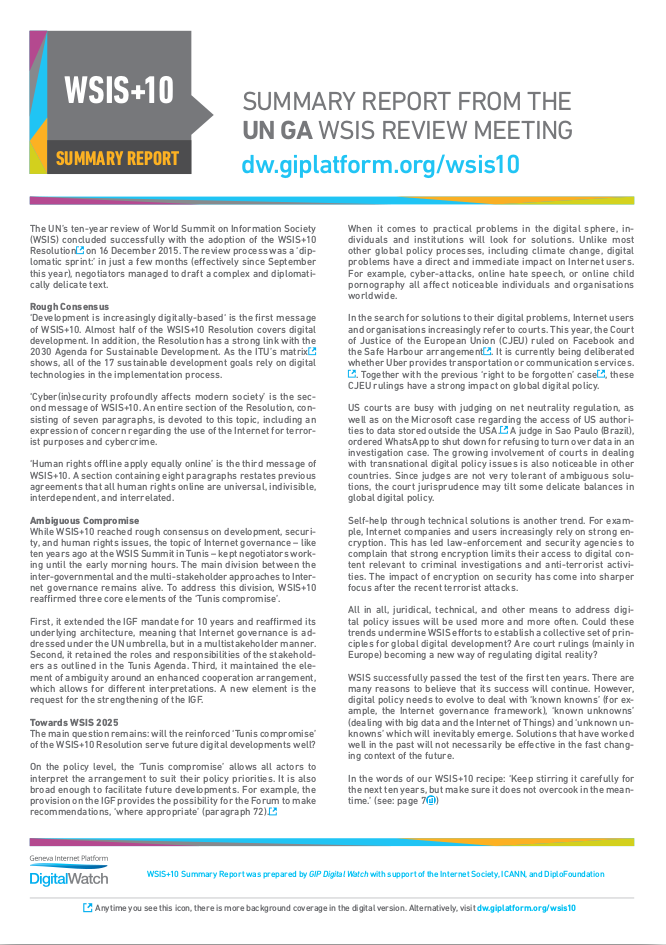 |
From Diplo Creative Lab

WSIS+10 Selfie at UNGA
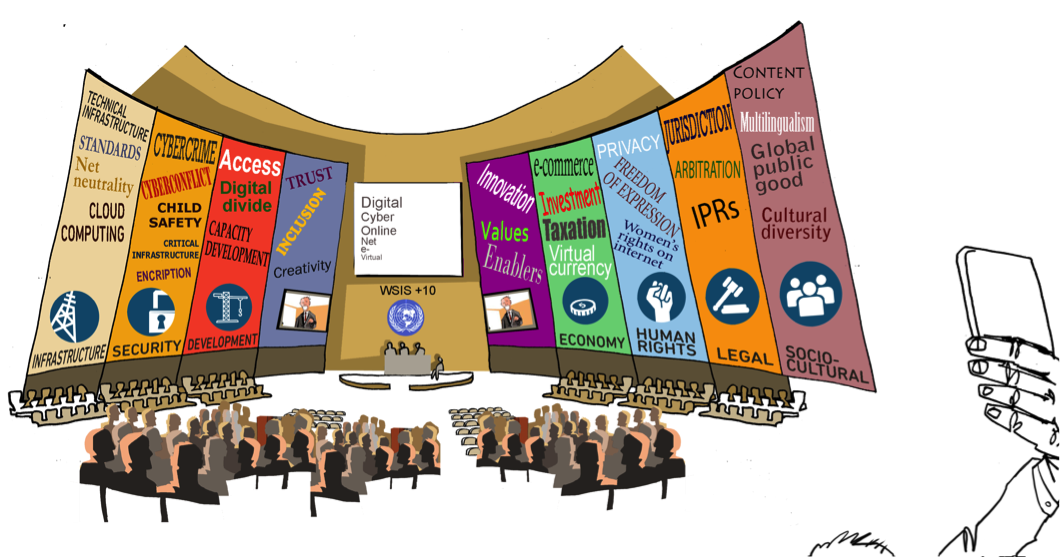
Overview of instruments referred to in the WSIS+10 outcome document
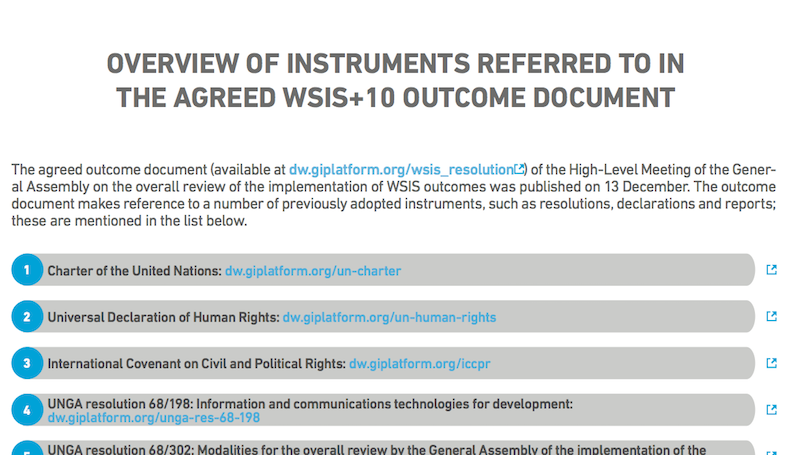
WSIS+10 Resolution: Document Paragraph Network
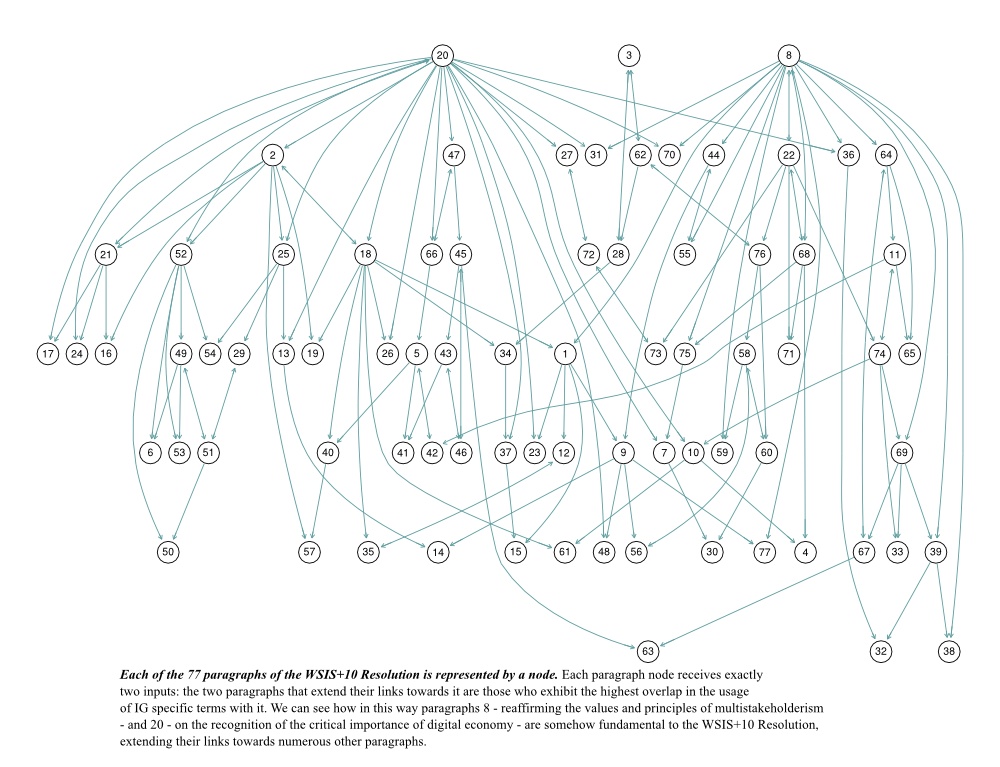
Paragraph by paragraph sentiment analysis of the draft WSIS+10 outcome document
We submitted the draft Outcome Document of the High-Level Meeting of the General Assembly on the Overall Review of the Implementation of WSIS Outcomes (the WSIS+10 Resolution) to a computational sentiment analysis. This analysis works by recognising emotionally charged words – both positive and negative – in the text, and then using the frequency of their occurrences to calculate a polarity score that ranges from -1 (completely negative) to +1 (completely positive) for any given text.
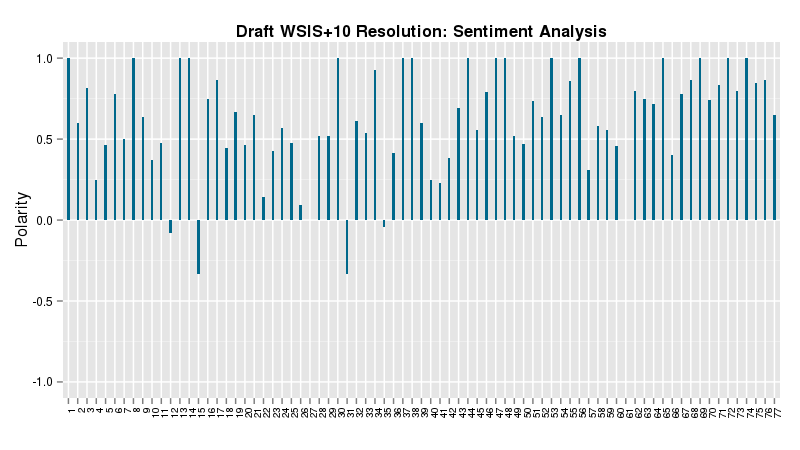
We computed the polarity score for each paragraph in the draft Outcome Document separately. Only 4 out of 77 paragraphs bear negative sentiments (paragraph 12: conflicts and disasters; paragraph 15: harassment, crime, terrorism; paragraph 31: on digital divides; paragraph 35: challenges, conflicts, disasters). However, huge variations are present on the positive side that encompasses the majority of the document. For example, the lowest scoring paragraph of positive polarity is paragraph 26 (on the many forms of digital divides that still prevail). Occurrences of positive and negative words balance each other in the computation of polarity.
Text-mining of the draft Outcome Document of the High-Level Meeting of the General Assembly on the Overall Review of the Implementation of WSIS Outcomes
- Diplo’s Text-Analytical Framework (DTAF) was used to assess the IG semantics in the draft Outcome Document of the WSIS+10 Review Process.
- The IGF Knowledge Model – a set of manually annotated and statistically modeled IGF session transcripts – was projected onto the contents of the draft Outcome Document.
- The explicit and implicit relevance of 40 IG issues was computed:
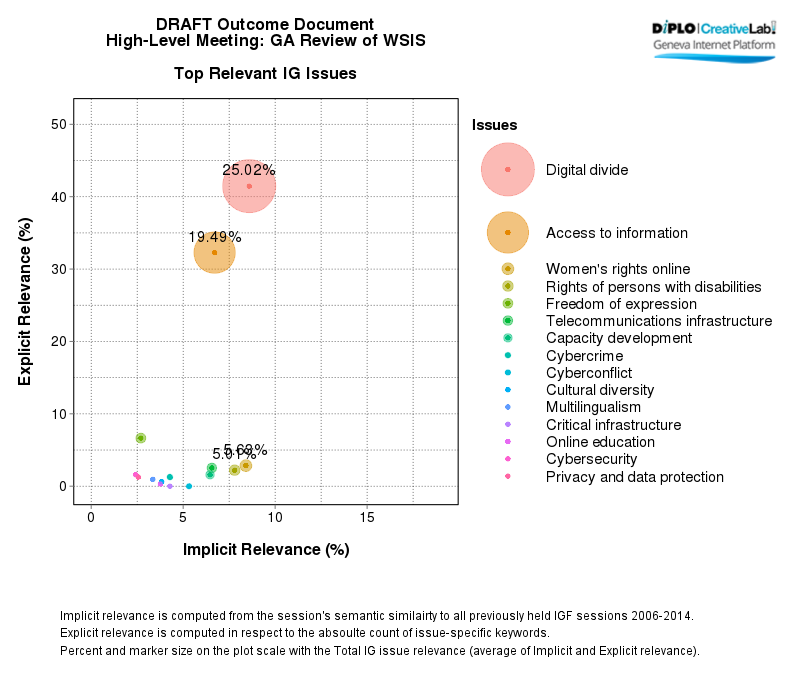
IG basket-level analysis
A similar analysis was conducted on another level, computing the relevance of seven IG baskets (or IG clusters), each encompassing many specific IG issues:
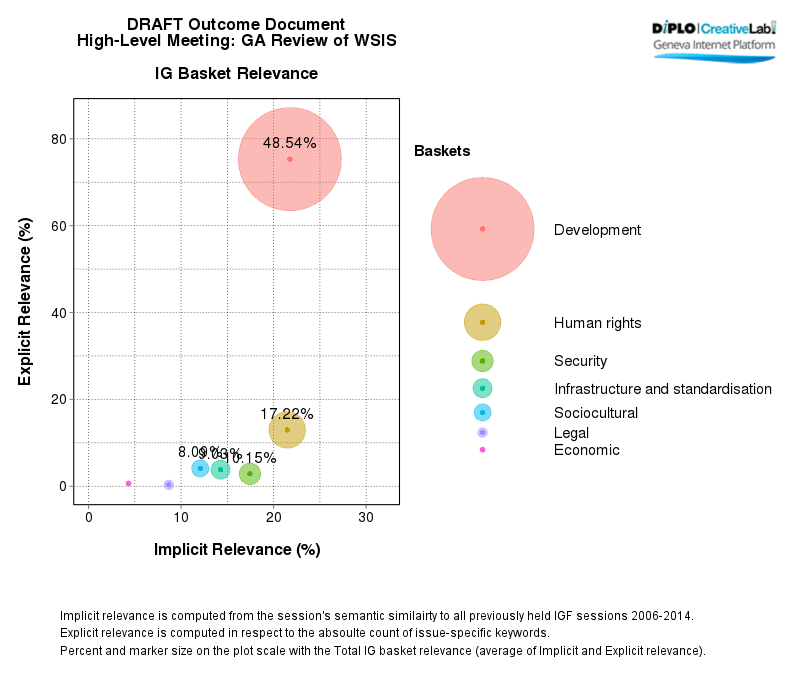
Sentiment analysis
Sentiment analysis, a computational method that recognises emotionally-charged words in a text and computes its overall affective tone based on the extent of their usage, revealed that the general sentiment of the draft is positive:
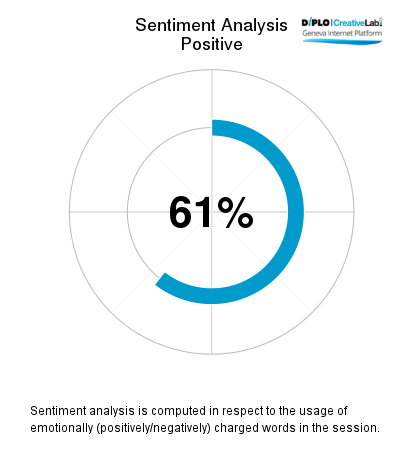
Associative paths: The mutual relations among the top relevant IG issues
Further insights were gathered on the way different IG issues are related in the draft Outcome Document. The following N-Graph presents the top ten relevant IG issues recognised in the draft Outcome Document. Each issue in the graph receives exactly two inputs: the two issues that extend their links towards it are the two issues most semantically related to it.
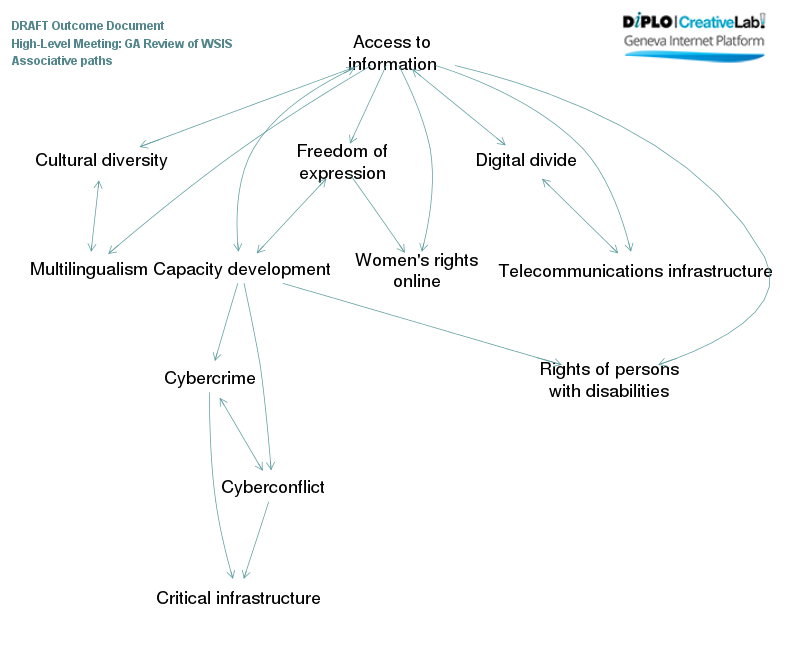
WSIS+10 Illustrations

